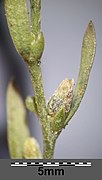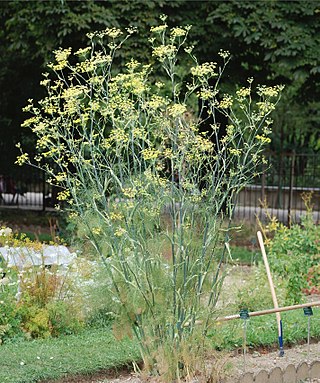
Fennel is a flowering plant species in the carrot family. It is a hardy, perennial herb with yellow flowers and feathery leaves. It is indigenous to the shores of the Mediterranean but has become widely naturalized in many parts of the world, especially on dry soils near the sea coast and on riverbanks.

The Cyperaceae are a family of graminoid (grass-like), monocotyledonous flowering plants known as sedges. The family is large: botanists have described some 5,500 known species in about 90 genera, the largest being the "true sedges" with over 2,000 species.

Brooklyn Botanic Garden (BBG) is a botanical garden in the borough of Brooklyn in New York City. The botanical garden occupies 52 acres (21 ha) in central Brooklyn, close to Mount Prospect Park, Prospect Park, and the Brooklyn Museum. Designed by the Olmsted Brothers, BBG holds over 14,000 taxa of plants and has over 800,000 visitors each year. It includes a number of specialty gardens, plant collections, and structures. BBG hosts numerous educational programs, plant-science and conservation, and community horticulture initiatives, in addition to a herbarium collection.

The Missouri Botanical Garden is a botanical garden located at 4344 Shaw Boulevard in St. Louis, Missouri. It is also known informally as Shaw's Garden for founder and philanthropist Henry Shaw. Its herbarium, with more than 6.6 million specimens, is the second largest in North America, behind that of the New York Botanical Garden. The Index Herbariorum code assigned to the herbarium is MO and it is used when citing housed specimens.

Matricaria discoidea, commonly known as pineappleweed, wild chamomile, disc mayweed, and rayless mayweed, is an annual plant native to North America and introduced to Eurasia where it grows as a common herb of fields, gardens, and roadsides. It is in the daisy family Asteraceae. The flowers exude a chamomile/pineapple aroma when crushed. They are edible and have been used in salads and to make herbal tea.

Cercis is a genus of about 10 species in the subfamily Cercidoideae of the pea family Fabaceae. native It contains small deciduous trees or large shrubs commonly known as redbuds in the USA. They are characterised by simple, rounded to heart-shaped leaves and pinkish-red flowers borne in the early spring on bare leafless shoots, on both branches and trunk ("cauliflory"). The genus contains ten species, native to warm temperate regions of North America, southern Europe, western and central Asia, and China.
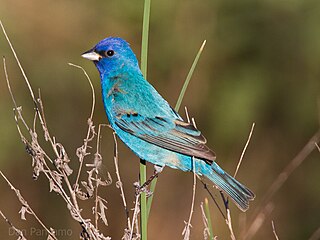
The indigo bunting is a small seed-eating bird in the cardinal family, Cardinalidae. It is migratory, ranging from southern Canada to northern Florida during the breeding season, and from southern Florida to northern South America during the winter. It often migrates by night, using the stars to navigate. Its habitat is farmland, brush areas, and open woodland. The indigo bunting is closely related to the lazuli bunting and interbreeds with the species where their ranges overlap.

Daphne is a genus of between 70 and 95 species of deciduous and evergreen shrubs in the family Thymelaeaceae, native to Asia, Europe and north Africa. They are noted for their scented flowers and often brightly coloured berries. Two species are used to make paper. Many species are grown in gardens as ornamental plants; the smaller species are often used in rock gardens. All parts of daphnes are poisonous, especially the berries.

Allium tricoccum is a bulbous perennial flowering plant in the amaryllis family Amaryllidaceae. It is a North American species of wild onion or garlic widespread across eastern Canada and the eastern United States. Many of the common English names for this plant are also used for other Allium species, particularly the similar Allium ursinum, which is native to Europe and Asia. An edible plant, Allium tricoccum is used in a variety of North American and indigenous cuisines, and has also been used by Native Americans in traditional medicine. A French rendering (chicagou) of a Native American name for this plant is the namesake of the American city of Chicago.
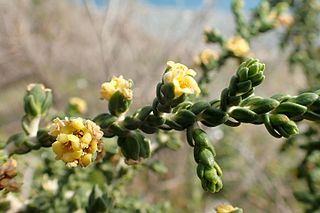
The Thymelaeaceae are a cosmopolitan family of flowering plants composed of 50 genera and 898 species. It was established in 1789 by Antoine Laurent de Jussieu. The Thymelaeaceae are mostly trees and shrubs, with a few vines and herbaceous plants.

Amaranthus cruentus is a flowering plant species that yields the nutritious staple amaranth grain. It is one of three Amaranthus species cultivated as a grain source, the other two being Amaranthus hypochondriacus and Amaranthus caudatus. It has several common names, including blood amaranth, red amaranth, purple amaranth, prince's feather, and Mexican grain amaranth.
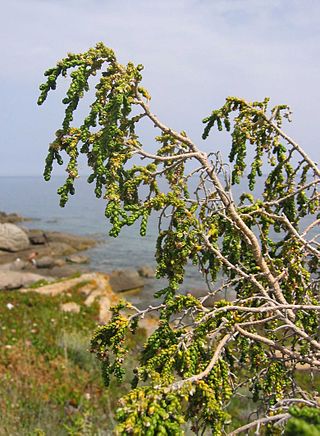
Thymelaea is a genus of about 30 species of evergreen shrubs and herbs in the flowering plant family Thymelaeaceae, native to the Canary Islands, the Mediterranean region, north to central Europe, and east to central Asia.

Jacobaea maritima, commonly known as silver ragwort, is a perennial plant species in the genus Jacobaea in the family Asteraceae, native to the Mediterranean region. It was formerly placed in the genus Senecio, and is still widely referred to as Senecio cineraria; see the list of synonyms (right) for other names.

Aralia nudicaulis is a species of flowering plant in the ivy family Araliaceae. It is native to northern and eastern North America.

Buddleja davidii, also called summer lilac, butterfly-bush, or orange eye, is a species of flowering plant in the family Scrophulariaceae, native to Sichuan and Hubei provinces in central China, and also Japan. It is widely used as an ornamental plant, and many named varieties are in cultivation. The genus was named Buddleja after Reverend Adam Buddle, an English botanist. The species name davidii honors the French missionary and explorer in China, Father Armand David, who was the first European to report the shrub. It was found near Yichang by Dr Augustine Henry about 1887 and sent to St Petersburg. Another botanist-missionary in China, Jean-André Soulié, sent seed to the French nursery Vilmorin, and B. davidii entered commerce in the 1890s.
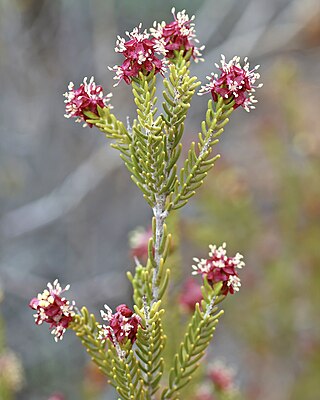
Passerina is a genus in the plant family Thymelaeaceae. They are ericoid bushes growing largely in fynbos and other Southern African scrub habitats.
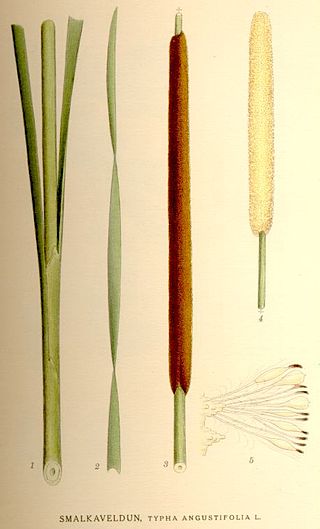
Typha angustifolia L. is a perennial herbaceous plant of genus Typha. This cattail is an "obligate wetland" species that is commonly found in the northern hemisphere in fresh water or brackish locations.

Shepherdia argentea, commonly called silver buffaloberry, bull berry, or thorny buffaloberry, is a species of Shepherdia in the Oleaster family.

Triodanis perfoliata, the clasping Venus' looking-glass or clasping bellflower, is an annual flowering plant belonging to the family Campanulaceae. It is an annual herb native to North and South America, the natural range extending from Canada to Argentina. It is also naturalized in China, Korea and Australia.

Thymelaea hirsuta, boalaga (Spanish), bufalaga, mitnan (Arabic) or shaggy sparrow-wort, is a xerophytic shrub which can grow to 2 metres in height and has a root system reaching depths of up to 3.5m. Some noteworthy characteristics of this species are the tiny size of its leaves and flowers and that both are also fleshy. Like many other species belonging to the family Thymelaeaceae, it is a toxic plant with medicinal properties that also yields a strong fibre used in the making of rope and paper.




